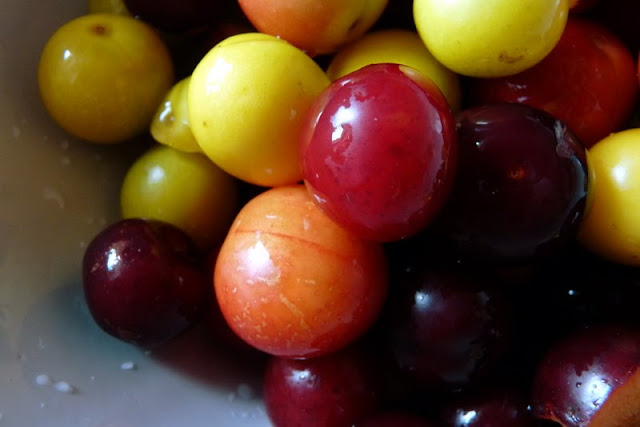Fine weather at last yesterday, and we were eager to be out, having been cooped up by the rain, and knowing that though the wind and wet would have brought down plenty of the mirabelle plums, they would also be dirty and bruised and probably wouldn't last long, and there might not be many left now on the trees.
On the way we passed plenty of other usable hedgerow fruits,
such as these wild crab apples. But we have a very prolific ornamental golden crab apple in the garden that yields more than I can possibly use. The jelly the fruit makes is excellent, deepening to a reddish amber.

Then there were the sloes, glowing blue and thick on the spiny blackthorn branches. These hard, intensely sour wild plum also make a good bright jelly, and best of all the steeped liqueur, sloe gin, which can cheer any winter day. But they can wait, they'll be better for it, and when we go to the Bay of Morlaix in September they will be there in abundance, judging by the amount of blossom we saw there in April, and the insects going to and fro in it.

There were blackberries a-plenty too,

and wilding apples to go with them.
However, I was heading for the mirabelle trees.
These are not wild trees, or even really indigenous. These little multicoloured plums were brought to Europe a long time ago from Asia, some legends attribute their introduction to Alexander the Great. They are particularly favoured in Alsace, and the chillier more mountainous regions, and it certainly seems from this last year that a hard long winter and a late dry spring is to their liking. Both their flowering and their fruiting seasons are quite short, and in years here when the spring comes earlier but then they are zapped by a late frost, or even when too much rain dampens the blossom and deters the insects, the yield of fruit is poor or non-existent. This year they have both flowered and fruited late and abundantly.
This hedge of them was planted many years ago, long before we came to live here, by a local farmer or landowner who was said to be fond of the trees, there is another planting nearer the top of the hill. It's one of my favourite places at all times of year, down a quiet lane, where the field openings offer changing views across the valley, and where, early and late in the year especially, the late afternoon sun falls with a good light.
In spring, the blossom on the trees makes a promising, gentle smoky streak across the green,

and closer to, are delicate and cheering.
Though the season is short, the man planted several varieties, which fruit in succession.

Some are quite a deep red,
some are a lighter, shaded red-gold, and are a larger fruit,

others are the small yellow traditional mirabelles which people tend to know best.

and one or two trees produce these dark purplish plums. I picked these a week or so ago, by climbing, hooking the camera and the dog to adjacant trees ( Mol tends to get bored and wander off among the maize rows, where she then gets lost).
At first I was afraid I was out of luck, much of the yellow and purple fruit was finished, and the windfalls were too rotten and far-gone to be worthwhile. Other plums remained on the trees, but were out of reach. But then I found a marvellous bejewelled hoard of red ones, strewn on the ground, a little muddy but very sound, and other corners yielded more of the other kinds.
I gathered several kilos in a plastic carrier bag, the best receptacle as they can be squashy and messy, which I slung over the stick I'd taken to try to bash or hook them down (fruitlessly!), and carried home, Dick Whittington style, over my shoulder.

I spent a happy afternoon washing and picking them over, then pulling out the stones with my fingers. By chance I found a good radio programme of Renaissance polyphony to listen to. Every sense was catered for, and I felt there ought to be a poem in a polyphony of plums...
The larger, more orange-coloured ones were the least ripe, and had a taste a little like nectarines. The dark purplish ones are sunset orange inside.

It was most important to get them beyond perishing. I boiled a kilo of them up quickly with a smidgin of sugar for making jam later,

the rest being destined for chutney, were mixed in with the statutory pound to a pint (we are between two worlds when it comes to weights and measures, and probably more besides...) of sugar and vinegar, spices added - is there anything more blissful to stick your nose into than a mortar-full of toasted coriander as it is ground? -and left to stand overnight.
So that's the project for today.






























